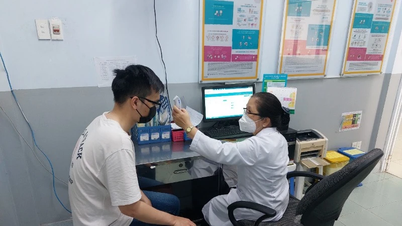
Diabetics need to pay attention to safety when driving - Photo: AI
In Vietnam, according to current regulations on health standards for drivers, people with diabetes (diabetes) with a history of diabetic coma within 1 month will not be eligible to drive in group 3 (driving class: C1, C, D1, D2, D, BE, C1E, CE, D1E, D2E and DE).
However, diabetic patients without a history of coma should also be careful when driving. According to Dr. Nguyen Quang Bay - Head of the Department of Endocrinology - Diabetes, Bach Mai Hospital, during the examination and prescription process for patients, he always asks questions about the patient's occupation.
"If the patient is a driver, it usually takes at least 3-5 more minutes to discuss the disease and the risks of driving in more detail," Dr. Bay shared.
According to this expert, from consulting guidelines from other countries, there is much controversy about diabetics driving commercial vehicles or carrying passengers.
But most agree that they can drive their personal car to work or go out, but some factors need to be evaluated.
First, does the patient often have (severe) hypoglycemia?
Second, does the patient have any neurological complications in the legs and finally, does the patient have any eye complications that affect vision?
Dr. Bay shares the American Diabetes Association (ADA) guidelines for people with diabetes driving as follows:
For healthcare professionals
Discuss safe driving as part of a diabetes self-careeducation program.
Educate people with diabetes about complications related to hypoglycemia, loss of feeling in the feet, impaired vision, or cognitive impairment that can affect driving.
Discuss the risks associated with driving with people with diabetes regularly, not just at the time of diagnosis or when an incident occurs.
Assess the risks of people with diabetes driving when required.
Recommended safe driving practices.
For licensing authorities
Understand that diabetes itself is not directly related to driving problems.
Use a brief questionnaire to identify drivers with diabetes at high risk of driving (some, not all, drivers with diabetes), based on individualized factors.
Based on the conclusions of the treating physician to make recommendations appropriate to each case.
Only suspend or revoke a diabetic's driver's license if it is the only way to clearly avoid the risks.
Avoid suspending a driver's license when a patient has severe hypoglycemia if the treating physician and the patient can explain and overcome the problem to prevent recurrence.
Maintain medical review boards, including diabetes experts, to assist in developing agency policy.
For drivers
Always have a blood glucose meter, candy, and snacks containing carbohydrates, fats, and proteins in your car. Test your blood glucose before driving and periodically during long trips.
If blood sugar before driving < 5.0 mmol/L (90 mg/dL): Eat more to increase blood sugar.
Stop driving immediately if you have symptoms of hypoglycemia to measure and adjust blood sugar if necessary.
Know how to treat hypoglycemia with fast-acting glucose, even if it is mild. Wait until your blood sugar and cognitive ability have recovered before driving.
Ask your diabetes health care professional if advanced technologies (CGM, automated insulin pump systems, etc.) are appropriate.
If there is a neurological complication that causes sensory disturbances in the legs, the car must have a manual control unit instead.
Source: https://tuoitre.vn/nguy-hiem-nao-rinh-rap-khi-nguoi-benh-dai-thao-duong-lai-xe-o-to-20250402223333296.htm


![[Photo] General Secretary To Lam chairs a working session with the Central Internal Affairs Commission](https://vphoto.vietnam.vn/thumb/1200x675/vietnam/resource/IMAGE/2025/5/22/3b7790f499da45b2803d8ae253207ef1)

![[Photo] Prime Minister Pham Minh Chinh chairs meeting on draft Resolution of National Assembly on International Financial Center in Vietnam](https://vphoto.vietnam.vn/thumb/1200x675/vietnam/resource/IMAGE/2025/5/22/d398664ff1a140629169ea5a24e1b4d0)
![[Photo] Prime Minister Pham Minh Chinh chairs the Government's special meeting on law-making in May](https://vphoto.vietnam.vn/thumb/1200x675/vietnam/resource/IMAGE/2025/5/22/1c880aae96fd4e0894abc47a46fe19ba)

![[Photo] Press delegation meeting to visit Truong Sa and DK1 Platform](https://vphoto.vietnam.vn/thumb/1200x675/vietnam/resource/IMAGE/2025/5/22/6b8d232877ec421a9e8187d83b9f8006)











































































![[Podcast] Week introducing more than 500 OCOP products in Hanoi](https://vphoto.vietnam.vn/thumb/402x226/vietnam/resource/IMAGE/2025/5/22/d144aac2416744718388dbae3260e7fd)





Comment (0)